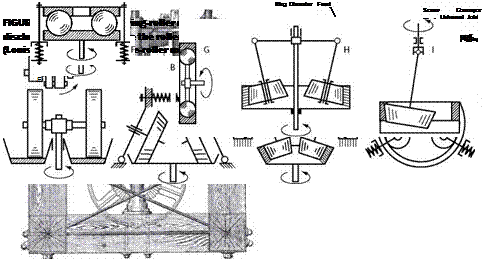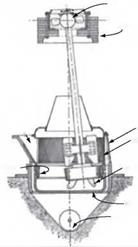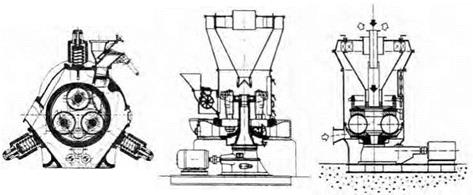The Maxecon mill had a vertical grinding ring rotating around a horizontal axis and three convex horizontal rollers that rotated independently and were pressed against its
 |
 FIGURE 6.9 Diagrams of ring-roller mills: (a) Chilean mill in which a vertical shaft rotates heavy cylindrical rollers around a plane ring race (b and c) Loesche mills and disk-type Raymond mills in which rollers are pressed by springs against the race that rotates (d) Maxecon mills and Kent mills in which three convex rollers are pressed by springs against a complementary concave race fixed to a rotating ring (e) Babcock & Wilcox mill or Fuller-Peters mill in which roller balls are placed between two races, the lower being driven and the upper being pressed by springs against the balls (f and g) Fuller mills and Sturtevant roulette mills in which spherical rollers driven around a stationary ring are pressed by centrifugal force against the race (h and i) Raymond or Bradley multi-pendulum mill and Griffin single pendulum mill in which the grinding pressure results from centrifugal force as the rollers attached to each arm suspended from a pivot press against a fixed race as the shaft rotates (Tarjan 1981)
FIGURE 6.9 Diagrams of ring-roller mills: (a) Chilean mill in which a vertical shaft rotates heavy cylindrical rollers around a plane ring race (b and c) Loesche mills and disk-type Raymond mills in which rollers are pressed by springs against the race that rotates (d) Maxecon mills and Kent mills in which three convex rollers are pressed by springs against a complementary concave race fixed to a rotating ring (e) Babcock & Wilcox mill or Fuller-Peters mill in which roller balls are placed between two races, the lower being driven and the upper being pressed by springs against the balls (f and g) Fuller mills and Sturtevant roulette mills in which spherical rollers driven around a stationary ring are pressed by centrifugal force against the race (h and i) Raymond or Bradley multi-pendulum mill and Griffin single pendulum mill in which the grinding pressure results from centrifugal force as the rollers attached to each arm suspended from a pivot press against a fixed race as the shaft rotates (Tarjan 1981)
|
ABC FIGURE 6.10 (a) Maxecon ring-roller (b) Raymond centrifugal ring-roller (c) Fuller ring-ball mills (Brundiek 1989; reprinted by permission from Loesche) |
concave inner surface. One roller was driven by an external motor and moved the grinding ring by friction. The feed entered the grinding zone, and centrifugal force held the particles at the ring and as they passed under the rolls. The product was discharged from the edge of the ring. The Maxecon mill was very successful, and many were sold by von Grueber’s company for grinding phosphate rock and limestone. Eventually 600 machines were supplied to various industries. In 1924, two Maxecon mills were used as coal pulverizers at the Moabit power station operated by Berliner Elektrizitatswerke (BEWAG), and an indication of their success was that two more were added when the station was expanded. Their capacity was 5 tph, but the possibility for increasing the capacity was limited because their geometry permitted only a small increase in roller diameter.

